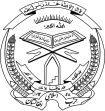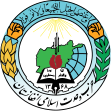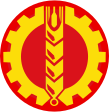
Ahmad Shah Massoud was an Afghan politician and military commander. He was a powerful guerrilla commander during the resistance against the Soviet occupation between 1979 and 1989. In the 1990s, he led the government's military wing against rival militias; after the Taliban takeover, he was the leading opposition commander against their regime until his assassination in 2001.

Burhānuddīn Rabbānī was an Afghan politician and teacher who served as President of Afghanistan from 1992 to 1996, and again from November to December 2001.

The Taliban, which also refers to itself by its state name, the Islamic Emirate of Afghanistan, is an afghan militant movement in Afghanistan with an ideology comprising elements of Pashtun nationalism and the Deobandi current of Islamic fundamentalism. It ruled approximately three-quarters of the country from 1996 to 2001, before being overthrown following the American invasion. It recaptured Kabul on 15 August 2021 following the departure of most coalition forces, after nearly 20 years of insurgency, and currently controls all of the country. Its government is not recognized by any country. The Taliban government has been internationally condemned for restricting human rights in Afghanistan, including the right of women and girls to work and to have an education.
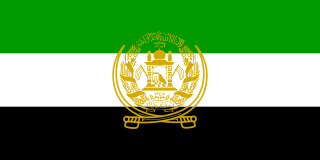
The Islamic State of Afghanistan was established by the Peshawar Accords of 26 April 1992. Many Afghan mujahideen parties participated in its creation, after the fall of the socialist government. Its power was limited due to the country's second civil war, which was won by the Taliban, who took control of Kabul in 1996. The Islamic state then transitioned to a government in exile and led the anti-Taliban Northern Alliance. It remained the internationally recognized government of Afghanistan at the United Nations until 2001, when the Transitional Islamic State of Afghanistan was created and an Afghan Interim Administration took control of Afghanistan with US and NATO assistance following the overthrow of the first Taliban government. The Transitional Islamic State was subsequently transformed into the Islamic Republic, which existed until the Taliban seized power again in 2021 following a prolonged insurgency.
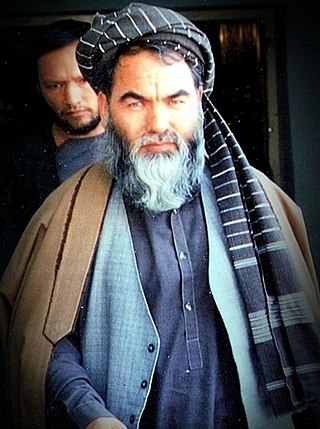
Abdul Ali Mazari was an Afghan Hazara politician and leader of the Hezbe Wahdat during and following the Soviet–Afghan War, who advocated for a federal system of governance in Afghanistan. He believed that this would end political and ethnic division in Afghanistan by guaranteeing rights to every ethnic group. He was allegedly captured and murdered by the Taliban during negotiations in 1995. In 2016, he was posthumously given the title "Martyr for National Unity of Afghanistan" and had a statue erected in his honor by the Islamic Republic of Afghanistan. Shortly after reclaiming power, the Taliban demolished the statue.

The prime minister of Afghanistan, officially the prime minister of the Islamic Emirate of Afghanistan, is the head of government of Afghanistan.

The Council of Ministers of the Islamic Emirate of Afghanistan is the executive body of the government of Afghanistan, responsible for day-to-day governance and the implementation of policy set by the Leadership. It is headed by the prime minister—who serves as the nation's head of government—and his deputies, and consists of the heads and deputy heads of the government ministries.

Lesbian, gay, bisexual, and transgender (LGBT) people in the Islamic Emirate of Afghanistan face severe challenges not experienced by non-LGBT residents. Afghan members of the LGBT community are forced to keep their gender identity and sexual orientation secret, in fear of violence and the death penalty. The religious nature of the country has limited any opportunity for public discussion, with any mention of homosexuality and related terms deemed taboo.

The 1996–2001 Afghan Civil War, also known as the Third Afghan Civil War, took place between the Taliban's conquest of Kabul and their establishing of the Islamic Emirate of Afghanistan on 27 September 1996, and the US and UK invasion of Afghanistan on 7 October 2001: a period that was part of the Afghan Civil War that had started in 1989, and also part of the war in Afghanistan that had started in 1978.

The Afghan conflict refers to the series of events that have kept Afghanistan in a near-continuous state of armed conflict since the 1970s. Early instability followed the collapse of the Kingdom of Afghanistan in the largely non-violent 1973 coup d'état, which deposed Afghan monarch Mohammad Zahir Shah in absentia, ending his 40-year-long reign. With the concurrent establishment of the Republic of Afghanistan, headed by Mohammad Daoud Khan, the country's relatively peaceful and stable period in modern history came to an end. However, all-out fighting did not erupt until after 1978, when the Saur Revolution violently overthrew Khan's government and established the Democratic Republic of Afghanistan. Subsequent unrest over the radical reforms that were being pushed by the then-ruling People's Democratic Party of Afghanistan (PDPA) led to unprecedented violence, prompting a large-scale pro-PDPA military intervention by the Soviet Union in 1979. In the ensuing Soviet–Afghan War, the anti-Soviet Afghan mujahideen received extensive support from Pakistan, the United States, and Saudi Arabia in a joint covert effort that was dubbed Operation Cyclone.

The 1964 Constitution of Afghanistan was the supreme law of the Kingdom of Afghanistan from 1964 to 1973, when it was annulled following a coup d'état though parts of the constitution were restored by future governments from 2002 to 2004 and from 2021 to 2022. It was drafted by a committee of foreign-educated Afghans, including Sardar Abdul Hakim Ziai and Sardar Abdul Rahim Ziai, appointed for the task by the Afghan King, Mohammad Zahir Shah. The primary goals of the Constitution were to prepare the government and the people for gradual movement toward democracy and socioeconomic modernization. A Loya jirga had debated, modified and approved its innovations, which included a bill of rights for all Afghans, explicitly including women. After public review, the constitution was put into effect in October 1964.

Mullah Hibatullah Akhundzada, also spelled Haibatullah Akhunzada, is an Afghan Deobandi Islamic scholar, cleric, and jurist who is the supreme leader of Afghanistan. He has led the Taliban since 2016, and came to power with its victory over U.S.-backed forces in the 2001–2021 war. A highly reclusive figure, he has almost no digital footprint except for an unverified photograph and several audio recordings of speeches.

The Afghan Armed Forces, officially the Armed Forces of the Islamic Emirate of Afghanistan, also referred to as the Islamic Emirate Armed Forces, is the military of Afghanistan, commanded by the Taliban government from 1997 to 2001 and since August 2021. According to Afghanistan's Ministry of Defense, its total manpower is 170,000.

Sher Mohammad Abbas Stanikzai is a senior member of the Afghan Taliban and the country's Deputy Minister of Foreign Affairs since 7 September 2021.

The supreme leader of Afghanistan, officially the supreme leader of the Islamic Emirate of Afghanistan and also styled by his religious title Amir al-Mu'minin, is the absolute ruler, head of state, and national religious leader of Afghanistan, as well as the leader of the Taliban. The supreme leader wields unlimited authority and is the ultimate source of all law.

The Taliban has ruled Afghanistan as the Islamic Emirate of Afghanistan since taking control by force in 2021, overthrowing the internationally recognized Islamic Republic of Afghanistan. The takeover was widely criticized by the international community, and no countries have extended diplomatic recognition to the new regime, despite nominally maintaining relations with Afghanistan. The Taliban has campaigned for international recognition since the takeover. Several countries have vowed never to recognize the Islamic Emirate, and others have said they will do so only if human rights in the country are respected. Some countries have accredited Taliban diplomats at the chargé d'affaires level despite not recognizing the Islamic Emirate. In September 2023, China became the first country to formally name a new ambassador to the country since the takeover, and in January 2024 recognized the Taliban's envoy to China; however, China still does not formally recognize the Taliban.
The politics of Afghanistan are based on a totalitarian emirate within the Islamic theocracy in which the Taliban Movement holds a monopoly on power. Dissent is not permitted, and politics are mostly limited to internal Taliban policy debates and power struggles. As the government is provisional, there is no constitution or other basis for the rule of law. The structure is autocratic, with all power concentrated in the hands of the supreme leader and his clerical advisors. According to the V-Dem Democracy indices Afghanistan was as of 2023 the 4th least electoral democratic country in the world.
The government of Afghanistan, officially called the Islamic Emirate of Afghanistan, is the central government of Afghanistan, a unitary state. Under the leadership of the Taliban, the government is a theocracy and an emirate with political power concentrated in the hands of a supreme leader and his clerical advisors, collectively referred to as the Leadership. The Leadership makes all major policy decisions behind closed doors, which are then implemented by the country's civil service and judiciary. As Afghanistan is an Islamic state, governance is based on Sharia law and Pashtunwali, which the Taliban enforces strictly through extensive social and cultural policy.
Democracy in Afghanistan has been severely limited and characterized by short, unstable historical periods since the formation of the contemporary state of Afghanistan in the 20th century. Following the rise of power of Ghazi Amanullah Khan in 1919, the first elements of a democratic government in the country began to emerge, with the formation of a constitution and increased civil liberties. Amanullah's political reforms resulted in his overthrow and for much of the rest of the 20th century, until 1964, there was limited democratization in the country. With the establishment of a bicameral national legislature in 1964 by King Zahir Shah, political parties began to form; however, none of these reforms were lasting after Zahir Shah's removal from power in 1973 and the formation of an autocratic Afghanistan republic.


